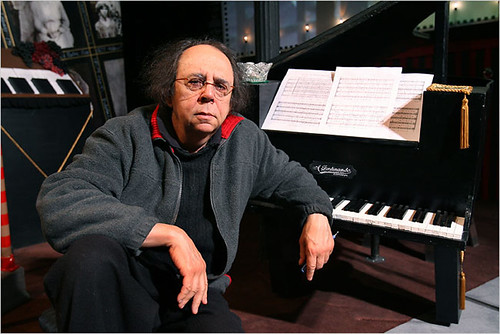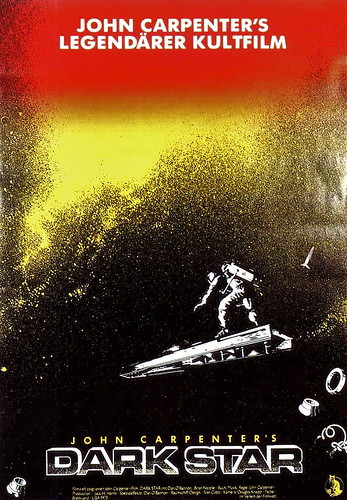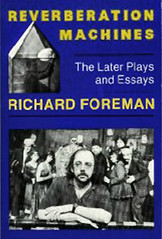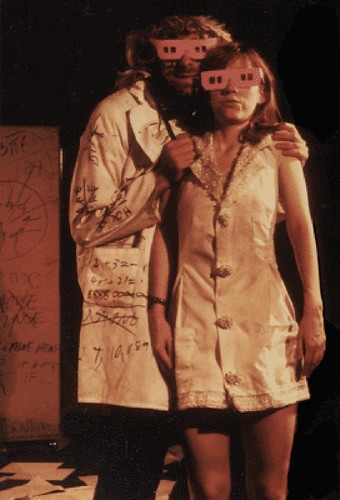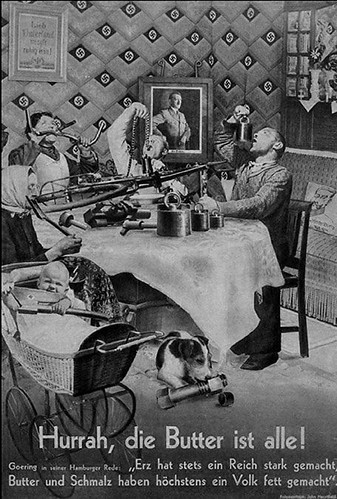
Apropos of the previous post, I had asked Ian to create a series of posts for this blog, describing each of the three shows that he has recently mounted at The Brick. Hopefully this will whet your appetite for seeing these shows! If so, act quickly - the close next weekend.
On Everything Must Go (Invisible Republic #2)For the first of three entries, each on one of the three shows Gemini CollisionWorks currently has running at The Brick, I thought I’d go with the one at the top of my mind, as I have a performance of it in about seven hours.
It is, however, the hardest one to trace the lineage of . . . the other night, after our most recent performance, we had an audience that really enjoyed the show, but which then also came into the lobby afterwards wanting to talk with me about “What was that about?” and “Where did that come from?” And with this show, those questions aren’t so easy to answer. I did my best, and thinking about it then made it a little easier to deal with now.
It started (kind of) by deciding that I was going to create two original shows this year, at least. It might have been three, but I had first made this decision before the theme for the Summer festival at The Brick was announced, and when that turned out to be The Film Festival I knew it was the time to finally do my long-standing dream project, The Magnificent Ambersons by Orson Welles: A Reconstruction for the Stage rather than create an original work around the theme.
So, two original shows, both to go up in August. Spell was already bubbling at the top of my mind, not fully formed, but about as formed as I wanted it to be before going into rehearsal. As for the other one, the only thing I knew was that I wanted it to be built around a series of dances. I had a few dances planned out in my head for years to several songs, and started from the handful of those I thought could work in the context of a new play, which wound up being the dances I had dreamed to the songs “Slug” by Passengers (aka Brian Eno and U2), “Transylvanian Concubine” by Rasputina, and “Episode of Blonde” by Elvis Costello.
In the end, the latter two dances would wind up being very little like what I had pictured in my head for years (and the first almost identical) but that was the starting point.
My 2006 show That’s What We’re Here For (an american pageant) was a big, sprawling, ungainly piece that I’d like to bring back someday and fix and get completely right. It still had a lot of great things in it, especially the musical numbers, which were much liked. I got a lot of complements for them, my first baby-step into a land of dance and choreography that I’d been wanting to play in, but was too nervous about my own skills to really commit to. The praise I got for that show convinced me finally that, okay, time to do the full-out dance-theatre piece.
So I started with those dances that had been in my head for a while. Then I tried to imagine where all this could be taking place, and what came to mind was an office, and I could see the line up of desks where they could make the space interesting and also both facilitate some dance and at the same time interestingly restrict it. So what did this office produce?
Often, when creating a fake business like this, I just say they make “widgets” and leave it blank otherwise, but the more I thought about the space, it seemed to be a place where plans for selling things were schemed together. My love-hate relationship with the language of the advertising world began to come to the fore (as well as the more general officespeak that has become the province of the post-60s MBA-influenced corporate world). So it started to become “a play in dance and speech,” as I was thinking of it. I now saw mounds and mounds of jargon and more jargon and bad American speech broken up by explosions into musical numbers as releases from the tension of this horrible workplace.
Since I wanted to create this (and Spell) by going into rehearsal with a bare minimum of text and plans, and building the show around the actual voices and bodies of the performers who would be doing it, and go where that led me, I then had to start thinking about casting. I thought I’d have about 12-14 people in the show, and the only people I knew specifically that I had worked with before that I saw in this world and wanted to do the show were Gyda Arber and Dina Rose – both dancers, but of very different kinds – and Maggie Cino, with whom I’d done a well-received dance in TWWHF, and whose training is mostly in movement/acrobatics, which led to the rest of the casting in that I was now looking for dancers, or actors who could dance or at least move well, of a wide variety of types. I had two others on board for a while that I knew, but both of them had to drop out – and, not altogether smartly, I then took on the role of The Big Man – the boss of the agency – myself, which put more pressure on me during the process of this (and the other two shows) than I should have been handling.
A number of the people in the cast were new to me – actors I had been auditioning for a show I directed at Metropolitan Playhouse earlier this year - Merry Mount - or for Ambersons. Several people wound up coming from the company of Merry Mount, and another few from the auditions for Ambersons (in the case of David Arthur Bachrach, he wound up in both Ambersons and this).
After a lot of juggling around, losing some people, gaining others, we wound up with our cast of 11 – eight women and three men.
So, rehearsals. These at first consisted of me placing people around the room, looking at the pictures, and deciding what potential scenes these suggested. The cast and Berit would bounce ideas around as well, more movement would happen, and then I’d go home and write fragments of script, which I’d bring in and work at the next rehearsal. Then repeat this. Once there was the semblance of a structure, we started work on the dances.
The show went through a number of different titles before settling on the last, perfect one. For a while it was Dance To That Which One Is Created For, which is awful (and a quote from Glen or Glenda?), and for the longest time it was Invisible Republic, which I wasn’t happy with, until I realized it was a good and accurate subtitle. Everything Must Go just popped into my head one day, and was obviously right.
As I was writing, it was also apparent that, as with That’s What We’re Here For, the characters would all have stream-of-consciousness monologues about themselves, and between that, some of the Americana of the script, the quotes and use of verbal kitsch, and other connections, it became obvious that this show was #2 in a series beginning with TWWHF, which retroactively became subtitled (Invisible Republic #1). So now, between this and the NECROPOLIS plays, I have two continuing theatrical series I look to be going back to, both with their own specific rules and forms that must be kept to.
To my surprise, the dances came easy (at least easier than expected) and the writing was difficult (FAR more difficult than expected). I had some of the dances in my head, yes, but when confronted with working with REAL trained dancers on the pieces, I first tended to freeze up a bit. Even with all that, I was able to get across what I wanted, and was stunned as “Slug” and “Handsome Man” came to life in one evening in a tiny room at Champions Studios. Some of the numbers were very much choreographed fully by me, some were supervised by me – I would give a specific outline, and the dancers would fill in what I was looking for, giving me options that I could choose from, and some were very much taken over by the dancer/actors themselves when I just drew a blank on where to go (though I’d always make changes/corrections before they were set). Some had to be painfully hacked out bit by bit, but more often it was a fun process constantly full of the feeling of “Why don’t we try THIS?”
Songs and structure changed along the way. The first love song I’d picked for Becky Byers’ character turned out to be far too “passionate” to be workable in the show, and it took me forever to find a replacement song with the qualities I wanted. Gyda Arber, the musical-theatre expert of the company, also pointed out that as the number was (technically speaking) the “I Wish” number in the show, and as such, it was set too far into it, structurally. Moving it earlier in the piece suddenly solved a number of structural problems, and made the whole thing begin to take on the overall feel of a musical, albeit one with no songs, but dance numbers set to pop music of the last 75 years or so.
However, the “book” was proving problematic. I knew what had to happen in each scene, but the words just weren’t coming. I certainly have had writers’ block in the past, but not normally when writing this kind of material, where it usually just flows easily out of me. This one had to be hacked away at, slowly, or I had to sit around and wait for hours until some bright flash came to me and I began tearing through pages rapidly, trying to get as much done as long as I had the inspiration going. I wound up finishing the last pages of dialogue a mere four days before we opened. But it all worked. Thankfully.
I’m NEVER really happy with anything I do. I just can’t be, it’s me. All I see are the things I don’t like and can’t fix. However, EMG may still bring me more joy more consistently than anything else I’ve done – seeing these dances, that this is a play of MINE that has these beautiful pieces of music and movement coming together – both some serious tap hoofing and a lovely pointe solo, and everything in between – it just makes me pleased and amazed that it’s a show of mine. How the hell did THIS happen?
So, there it is, a play in dance and speeches about one day in the life of an advertising agency. But WHY and WHAT IS IT REALLY ABOUT?
Which are good questions, and not ones I can answer with any confidence. To me, the perfect show is one where those questions are raised, but they can’t be answered except by viewing the show itself, and then you can only get a non-verbal, internal answer that makes sense but can’t be put into words without being reductive.
If I had to try and say myself, I’d say it’s a cautionary tale about selling out, and the way it can happen by small degrees, without being aware that it’s even happening, until humanity (represented in the dances) is lost in a mound of jargon and rules and structures that have nothing to do with human beings, and everything to do with planned ideas of “how to run things efficiently.”
There are people who know my work well, though, who always seem to think that every one of my pieces is itself about Art and more specifically about Theatre and the creation of it, and when that idea was floated to me the other night about this piece, I couldn’t find any holes in that way of looking at it – it does seem to be a metaphor for creating theatre, at least at the level I’ve been doing it for years now – with The Big Man (played, after all, by me) as Director, pulling his subordinates (actors) together against all odds to create this project that Has To Happen Now, with a combination of motivational speaking and careful guidance, until the final project happens, and all are proud of it . . . and then it’s ephemeral and goes away, and there’s just the next tiring project to move on to tomorrow. I’ve even placed in the mouth of my character phrases that I use all the time in directing actors.
So in the end, maybe it’s a more revealing piece than I imagined, about whether all this work that goes into these theatre projects is, in the end, worth it – the kind of thinking that is just a bit on my mind these days. Certainly wasn’t intended that way, though.
I just wanted to make a pretty play with dance numbers that was fun and at the same time had some bittersweet things to say about where America had come, especially in terms of selling things to people that they probably don’t really need and maybe aren’t so good for them.
After the show the other night, the friend of a cast member asked me, “So, are you an experimental director who’s playing with mainstream forms here, or are you a more mainstream director who’s getting a little more experimental with this piece?” At first I thought I knew how to answer that question, but after a moment’s reflection it seemed a lot less clear to me.
The final moments of Everything Must Go wound up taking their inspiration from a quote of Richard Foreman’s that was related to me by director Edward Einhorn, who interned for Richard on The Universe - at the end of that Foreman play, James Urbaniak’s character had to make a decision about drinking a glass of milk or not. It is somewhat obvious by this point in the play that the glass of milk represents BAD THINGS – everything that keeps human beings trapped in their little boxes, desiring the pleasures of the body rather than larger spiritual goals. In rehearsal, Richard still wasn’t decided on the ending, and one day said to Edward, “Now if he doesn’t drink the milk, it’s a comedy – if he DOES drink the milk, it’s a tragedy.”
In Foreman’s play, Urbaniak drinks the milk. A tragedy.
As we created the ending of Everything Must Go, Berit and I flashed on the same thing with our own situation . . . “If she leaves the pen, it’s a comedy – if she TAKES the pen, it’s a tragedy.” And had to decide ourselves which way it went.
So where did our play wind up? You’ll have to see it to find out . . .
